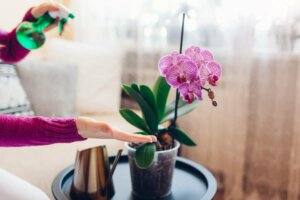How to Clean The Leaves of Plants to Make Them Shine

The care of plants isn’t limited to watering–after all, they’re more than an ornament, they’re part of our lives. An example of this is indoor plants, capable of helping to improve air quality, decrease stress levels and increase our productivity. In return, we must give them the care they require to keep them green and healthy. We’ll explain how to clean the leaves of your plants to make them shine.
In addition, you should know that beyond something aesthetic, this cleaning is necessary if your plants don’t receive rainwater. Keep in mind that dust that accumulates on the leaves affects respiration and the photosynthesis process, which can make it sick and even lead to the plant dying. In that sense, try to clean the leaves at least twice a month.
Make sure you know the plant species

This is a step that you can’t skip, as the type of plant you have determines the cleaning regime. Let’s learn a little more below:
- Large-leaved plants: should be sanitized using a microfiber cloth moistened with water and other products that serve to make them shine.
- Small-leaved plants: clean with a spray bottle.
- Velvety-leafed plants: a soft brush is recommended for cleaning, which may or may not be wet.
- Cactus and succulent species: cleaning these types of plants doesn’t require water and you can use an old brush or toothbrush to avoid harm from the thorns.
- Flowering plants: given their fragility, it’s not advisable to clean them. If the leaves or flowers have dried, they must be removed.
- Hanging plants: soak them for a while in warm water.
Make them shine! Choose the right type of water
Not all types of water are good for cleaning plant leaves. In general, demineralized water, also known as demi water or deionized water, is the most recommended. Some examples include rainwater, the water you use for your iron, and the water that comes out of the air conditioner (as long as it’s clean).
Now, consider that if you’ve not been taking care of your plants as you should, the layer of dust that you must remove may have a considerable thickness that you’ll not be able to remove with water alone. Therefore, mix water with a few drops of shower gel and then rinse the leaves clean with warm water. Finally, remember that cleaning should only involve the leaves–you shouldn’t touch the stems or flowers.
Plant care: shine time!
After cleaning with water and soap droplets you’ll likely see an improvement in the appearance of your plants. However, if they still look dull, you can search your pantry for certain products that work as natural brighteners. The most common are the following:
- Olive oil
- Beer
- Milk. There’s scientific evidence that in addition to shine and vigor, milk acts as an antifungal; that is, it inhibits the growth of fungi.
- Vinegar
- Bananas
For the application of most of these products, simply use a damp sponge or microfiber cloth and wipe it over the leaves without rinsing. However, in the case of banana plants, you can rub the leaves with the inside of the banana skin.
Likewise, you can help your plants to look radiant if you prepare a substrate from natural waste or eliminate the parts that are diseased or withered, for example.
Be careful when cleaning the leaves of your plants
Cleaning is associated with scrubbing until the dirt is gone, but in the case of plant leaves, this doesn’t apply. Even if you use a brush, care should be taken that the bristles aren’t too stiff.
In that sense, look for the most comfortable position to clean each of the leaves. You must start from the base and finish at the tips on both sides–and don’t rub them too hard.
Make them shine! After cleaning your plants let the leaves dry

After cleaning and applying natural brighteners, your plants should be dried in the open air. Of course, don’t forget that under the inclement rays of the sun, you may risk burning them. Alternatively, you can wipe them with a dry cloth to restore their dull appearance.
A cleaning routine to bring your plants back to life and make them shine
If your indoor plants look dull, consider cleaning them, especially if they don’t receive rainwater. To do this, determine what type of plant you have. Then you can use demineralized water to clean them according to their species. This can be carried out with a sponge, a microfiber cloth, an old toothbrush, or through immersion in water.
Then, proceed to apply a natural polish…either olive oil, beer, milk, among others. Finally, dry them in the open air, but don’t leave them for too long or you may end up burning the leaves.
The care of plants isn’t limited to watering–after all, they’re more than an ornament, they’re part of our lives. An example of this is indoor plants, capable of helping to improve air quality, decrease stress levels and increase our productivity. In return, we must give them the care they require to keep them green and healthy. We’ll explain how to clean the leaves of your plants to make them shine.
In addition, you should know that beyond something aesthetic, this cleaning is necessary if your plants don’t receive rainwater. Keep in mind that dust that accumulates on the leaves affects respiration and the photosynthesis process, which can make it sick and even lead to the plant dying. In that sense, try to clean the leaves at least twice a month.
Make sure you know the plant species

This is a step that you can’t skip, as the type of plant you have determines the cleaning regime. Let’s learn a little more below:
- Large-leaved plants: should be sanitized using a microfiber cloth moistened with water and other products that serve to make them shine.
- Small-leaved plants: clean with a spray bottle.
- Velvety-leafed plants: a soft brush is recommended for cleaning, which may or may not be wet.
- Cactus and succulent species: cleaning these types of plants doesn’t require water and you can use an old brush or toothbrush to avoid harm from the thorns.
- Flowering plants: given their fragility, it’s not advisable to clean them. If the leaves or flowers have dried, they must be removed.
- Hanging plants: soak them for a while in warm water.
Make them shine! Choose the right type of water
Not all types of water are good for cleaning plant leaves. In general, demineralized water, also known as demi water or deionized water, is the most recommended. Some examples include rainwater, the water you use for your iron, and the water that comes out of the air conditioner (as long as it’s clean).
Now, consider that if you’ve not been taking care of your plants as you should, the layer of dust that you must remove may have a considerable thickness that you’ll not be able to remove with water alone. Therefore, mix water with a few drops of shower gel and then rinse the leaves clean with warm water. Finally, remember that cleaning should only involve the leaves–you shouldn’t touch the stems or flowers.
Plant care: shine time!
After cleaning with water and soap droplets you’ll likely see an improvement in the appearance of your plants. However, if they still look dull, you can search your pantry for certain products that work as natural brighteners. The most common are the following:
- Olive oil
- Beer
- Milk. There’s scientific evidence that in addition to shine and vigor, milk acts as an antifungal; that is, it inhibits the growth of fungi.
- Vinegar
- Bananas
For the application of most of these products, simply use a damp sponge or microfiber cloth and wipe it over the leaves without rinsing. However, in the case of banana plants, you can rub the leaves with the inside of the banana skin.
Likewise, you can help your plants to look radiant if you prepare a substrate from natural waste or eliminate the parts that are diseased or withered, for example.
Be careful when cleaning the leaves of your plants
Cleaning is associated with scrubbing until the dirt is gone, but in the case of plant leaves, this doesn’t apply. Even if you use a brush, care should be taken that the bristles aren’t too stiff.
In that sense, look for the most comfortable position to clean each of the leaves. You must start from the base and finish at the tips on both sides–and don’t rub them too hard.
Make them shine! After cleaning your plants let the leaves dry

After cleaning and applying natural brighteners, your plants should be dried in the open air. Of course, don’t forget that under the inclement rays of the sun, you may risk burning them. Alternatively, you can wipe them with a dry cloth to restore their dull appearance.
A cleaning routine to bring your plants back to life and make them shine
If your indoor plants look dull, consider cleaning them, especially if they don’t receive rainwater. To do this, determine what type of plant you have. Then you can use demineralized water to clean them according to their species. This can be carried out with a sponge, a microfiber cloth, an old toothbrush, or through immersion in water.
Then, proceed to apply a natural polish…either olive oil, beer, milk, among others. Finally, dry them in the open air, but don’t leave them for too long or you may end up burning the leaves.
All cited sources were thoroughly reviewed by our team to ensure their quality, reliability, currency, and validity. The bibliography of this article was considered reliable and of academic or scientific accuracy.
- Lee, M. S., Lee, J., Park, B. J., & Miyazaki, Y. (2015). Interaction with indoor plants may reduce psychological and physiological stress by suppressing autonomic nervous system activity in young adults: a randomized crossover study. Journal of physiological anthropology, 34(1), 21. https://doi.org/10.1186/s40101-015-0060-8
- de Vries GE (2000). Milk as a fungicide. Trends in plant science, 5(1), 7.







